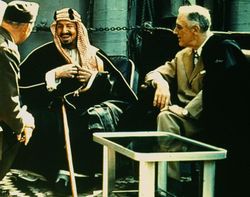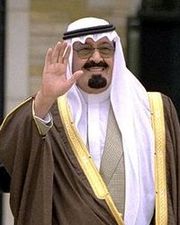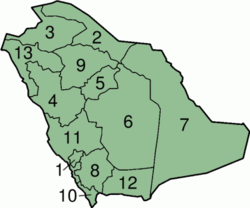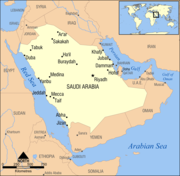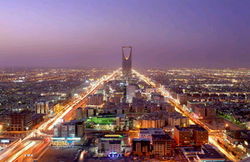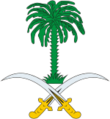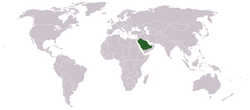|
SAUDI ARABIA
Please use our A to Z INDEX to navigate this site
|
|||||||||||||||||||||||||||||||||||||||
|
The Kingdom of Saudi Arabia is the largest country on the Arabian Peninsula. It borders Jordan on the north, Iraq on the north and north-east, Kuwait, Qatar, Bahrain, and the United Arab Emirates on the east, Oman on the south and south-east, and Yemen on the south, with the Persian Gulf to its north-east and the Red Sea to its west. It is called "the land of the two holy mosques", a reference to Mecca and Medina, Islam's two holiest places. It is also referred to as Saudi Arabia , السعودية or, less commonly, KSA.
Founder of modern Saudi Arabia, King Abdul Aziz, with President Franklin Delano Roosevelt returning from Yalta Conference in 1945
History
The Saudi state began in central Arabia in about 1750. A regional ruler, Muhammad bin Saud, joined forces with an Islamic reformer, Muhammad Abd Al-Wahhab, to create a new political entity. Over the next one hundred and fifty years, the fortunes of the Saud family rose and fell several times as Saudi rulers contended with Egypt, the Ottoman Empire, and other Arabian families for control on the peninsula. The modern Saudi state was founded by the late King Abdul Aziz Al-Saud (known internationally as Abdul Aziz Ibn Saud).
In 1902 Abdul Aziz Ibn Saud captured Riyadh, the Al-Saud dynasty's ancestral capital, from the rival Al-Rashid family. Continuing his conquests, Abdul Aziz subdued Al-Ahsa, Al-Qatif, the rest of Najd, and the Hijaz between 1913 and 1926. On 8 January 1926 Abdul Aziz Ibn Saud became the King of Hijaz. On 29 January 1927 he took the title King of Najd (his previous Najdi title was Sultan). By the Treaty of Jedda, signed on May 20, 1927, the United Kingdom recognized the independence of Abdul Aziz's realm, then known as the Kingdom of Hijaz and Nejd. In 1932, these regions were unified as the Kingdom of Saudi Arabia.
The discovery of oil in March 1938 transformed the country economically, and has given the kingdom great legitimacy over the years.
Besides Liechtenstein, Saudi Arabia remains the only country in the world whose common English name includes that of its ruling family. Many opponents of the House of Saud reject the family's legitimacy and decline to speak of the country as "Saudi Arabia".
Politics
The central institution of Saudi Arabian Government is the Saudi monarchy. The Basic Law adopted in 1992 declared that Saudi Arabia is a monarchy ruled by the sons and grandsons of the first king, Abd Al Aziz Al Saud, and that the Qur'an is the constitution of the country, which is governed on the basis of Islamic law (Shari'a).
King Abdullah of Saudi Arabia
There are no recognized political parties or national elections. The king is often classified as an absolute monarch, but his powers are theoretically limited within the bounds of Shari'a and other Saudi traditions. He also must retain a consensus of the Saudi royal family, religious leaders (ulema), and other important elements in Saudi society. The state's ideology is Salafi. This flavour of Islam spreads further by funding construction of mosques and Qur'an schools around the world. The leading members of the royal family choose the king from among themselves with the subsequent approval of the ulema.
Saudi kings have gradually developed a central government. Since 1953, the Council of Ministers, appointed by and responsible to the king, has advised on the formulation of general policy and directed the activities of the growing bureaucracy. This council consists of a prime minister, the first and second deputy prime ministers, 20 ministers (of whom the minister of defense also is the second deputy prime minister), two ministers of state, and a small number of advisers and heads of major autonomous organizations.
Legislation is by resolution of the Council of Ministers, ratified by royal decree, and must be compatible with the Shari'a (Islamic law). Justice is administered according to the Shari'a by a system of religious courts whose judges are appointed by the king on the recommendation of the Supreme Judicial Council, composed of 12 senior jurists. The independence of the judiciary is protected by law. The king acts as the highest court of appeal and has the power to pardon. Access to high officials (usually at a majlis, or public audience) and the right to petition them directly are well-established traditions.
Saudi Municipal elections took place in 2005 and some commentators saw this a first tentative step towards the intoduction of democratic processes in the Kingdom, including the legalisation of political parties. Other analysts of the Saudi political scene were more skeptical. [1]
DOOMSDAY OPERATION GRAND SLAM - Disillusioned extremists in Iran, North Korea and Russia, have grown impatient waiting for their leaders to act decisively, having watched the Ukraine debacle of Vladimir Putin rebound to weaken their CRINK axis members. This despite Hamas launching against Israel and Houthi attacks on the Red Sea. All that had the effect of waking the sleeping giant: NATO.
They
hatch a plot to kidnap top politicians from the west to create confusion,
as a prelude to an all out cyber
nuclear first and second strike, having first stockpiled sufficient gold
and weapons reserves, and fallout bunkers for their cells, to be able to
stage a second wave of conventional attacks, to in effect, take over the
world after the nuclear holocaust they
have engineered. Including assassinating their jaded leaders: Xi
Jinping; Vladimir
Putin, Iranian Grand Ayatollah, Ali
Khamenei, and Kim
Jong Un, supreme leader of communist North
Korea.
Human Rights
Saudi courts impose capital punishment and corporal punishment, including amputations of hands and feet for serious robbery, and floggings for lesser crimes such as "sexual deviance" (e.g. homosexuality) and drunkenness. The number of lashes is not clearly prescribed by law and varies according to the discretion of the presiding judges. The number ranges from dozens to several thousand, usually applied over a period of weeks or months. In 2002, the United Nations Committee against Torture criticised Saudi Arabia over the amputations and floggings it carries out under the Shari'a. The Saudi delegation responded defending "legal traditions" held since the inception of Islam in the region 1400 years ago and rejected interference in its legal system. (Source: BBC)
Religious Freedom
Saudi Arabia does not permit religious freedom and bans all non-Muslim worship. Non-Muslims, as well as Muslims who do not adhere to the Salafi sect of Sunni Islam can face punishment from the state and the Mutawwa'in (the religious police) Citizenship is restricted to Muslims, and non-Muslim common worship is punishable by law. The government maintains 50 Call and Guidance centers to encourage foreigners to convert to Islam. [3] Religious police enforce a modest code of dress and many institutions from schools to ministries are gender-segregated.
Provinces
Saudi Arabia is divided into 13 provinces (manatiq, singular - mintaqah).
Major Cities
Geography
The kingdom occupies eighty percent of the Arabian Peninsula. Most of the country's boundaries with the United Arab Emirates, Oman, and Yemen are undefined, so the exact size of the country remains unknown. The Saudi government's estimate is 2,217,949 square kilometers (856,355 sq mi). Other reputable estimates vary between 2,149,690 square kilometers (830,000 sq mi) and 2,240,000 square kilometers (864,869 sq mi).
The climate is dry and hot. Dry desert with great extremes of temperature and the terrain is mostly uninhabited, sandy desert. In most parts of the country, vegetation is limited to weeds, xerophytic herbs and shrubs. Animals include the ibex, wildcats, baboons, wolves, and hyenas in the highlands. Small birds are found in the oases. The coastal area of the Red Sea, especially the coral reefs, have a rich marine fauna. Saudi Arabia has a coastline of 2,640 kilometers (1,640 mi).
Saudi Arabia consists mostly of semi-desert and desert with oases. Almost half of the total country is uninhabitable desert with annual precipitation up to 100 millimetres (4 in) in most regions. The western regions are plateau and the east is lowland. The southwest region has mountains as high as 3,000 metres (9,840 ft), and is an area known for the greenest and freshest climate in all of the country. The capital, Riyadh, which is to the center-east has an average temperature in July of 42 °C (108°F) and 14 °C (57 °F) in January. In contrast, Jeddah on the western coast has 31 °C (88 °F) in July and 23 °C (73 °F) in January.
Less than 2 % of the total area is suitable for cultivation, and in the early 1990s, population distribution varied greatly among the towns of the eastern and western coastal areas, the densely populated interior oases, and the vast, almost empty deserts, such as the Rub' al Khali (desert), the Arabian Desert and East Sahero-Arabian xeric shrublands. There are no permanent rivers or lakes in Saudi Arabia.
Map of Saudi Arabia
Climate
Extreme heat and aridity are characteristic of most of Saudi Arabia. It is one of the few places in the world where summer temperatures above 50 °C (120 °F) are common, while in winter frost or snow can occur in the interior and the higher mountains. The average temperature range in January is 8° to 20 °C (47° to 68 °F) in Riyadh and 19° to 29 °C (66° to 83 °F) in Jeddah. The average range in July is 27° to 43 °C (81° to 109 °F) in Riyadh and 27° to 38 °C (80° to 100 °F) in Jeddah. Precipitation is usually sparse, although sudden downpours can lead to violent flash floods in wadis. Annual rainfall in Riyadh averages 100 mm (4 in) and falls almost exclusively between January and May; the average in Jeddah is 54 mm (2.1 in) and occurs between November and January.
Economy
Saudi Arabia has an oil-based economy with strong government controls over major economic activities. Saudi Arabia claims to be in possession of 260.1 billion barrels of oil reserves as of 2003, about 24% of the world's proven total petroleum reserves. It ranks as the largest exporter of petroleum and plays a leading role in OPEC.
Moreover, the proven reserves increase gradually as more oil fields are discovered, unlike most other oil-producing countries. The petroleum sector accounts for roughly 75% of budget revenues, 40% of the GDP, and 90% of export earnings. About 35% of the GDP comes from the private sector. Saudi Arabia was a key player in the successful efforts of OPEC and other oil producing countries to raise the price of oil in 1999 to its highest level since the Gulf War by reducing production. Saudi Arabia announced plans to begin privatizing the electricity companies in 1999, which followed the ongoing privatization of the telecommunications company. The government is expected to continue calling for private sector growth to lessen the kingdom's dependence on oil and increase employment opportunities for the swelling Saudi population. Shortages of water and rapid population growth may constrain government efforts to increase self-sufficiency in agricultural products.
In recent years, Saudi Arabia has experienced a significant contraction of oil revenues combined with a high rate of population growth. Per capita income has fallen from $25,000 in 1980 to $8,000 in 2003, up from about $7,000 in 1999. The decline in inflation-adjusted per-capita income from 1980 to 1999 set a record, being by far the worst such decline suffered by any nation-state in history.
Recently, with higher oil prices, however, Saudi Arabia's oil revenues have increased dramatically. Saudi Arabia's budget surplus has crossed $28 billion (SR110 billion) in 2005. The Tadawul (The Saudi stock market Index) (TASI) finished 2004 with a massive 76.23 % to close at 4437.58 points. Market capitalization was up 110.14 % from a year earlier to stand at $157.3 billion (SR589.93 billion), which makes it the biggest stock market in the Middle East.
Saudi Arabia officially became a WTO member in December 2005.
Riyadh downtown
Foreign Labour
Saudi Arabia is a destination for men and women from South and East Asia and East Africa seeking work. Hundreds of thousands of low-skilled workers from third world regions migrate voluntarily to Saudi Arabia.
Demographics
Saudi Arabia's population as of 2005 is estimated to be about 26.4 million, including about 5.6 million resident foreigners. Until the 1960s, most of the population was nomadic or semi-nomadic; due to rapid economic and urban growth, more than 95% of the population now is settled. The birth rate is 29.56 births per 1,000 people. The death rate is only 2.62 deaths per 1,000 people. Some cities and oases have densities of more than 1,000 people per square kilometre (2,600/sq mi).
Most Saudis are ethnically Arab. Some are of mixed ethnic origin and are descended from South Asians, Iranians, Malays, and others, most of whom immigrated as pilgrims and reside in the Hijaz region along the Red Sea coast. Many Arabs from nearby countries are employed in the kingdom. There also are significant numbers of South and South East Asian expatriates mostly from India, Pakistan, Bangladesh, Indonesia, and the Philippines. There are around 100,000 Westerners in Saudi Arabia, most of whom live in compounds or gated communities.
According to the CIA World Fact Book, 100% of Saudi Arabia's citizens are Muslims. [4]
The exit and entry visa cards ask applicants for their religious affiliation and officially bans entry to atheists, Jews or anyone with an official stamp from the State of Israel.
Culture
Saudi Arabian culture revolves almost entirely around the religion of Islam. Islam's two holiest sites, Mecca and Medina, are located in the country. Every day, five times a day, Muslims are called to prayer from the minarets of mosques which dot the country. The weekend consists of Thursday and Friday. The public practice of any religion other than Islam, including Christianity and Judaism, the presence of churches and open possession of Christian religious materials are outlawed in Saudi Arabia. Islam's holy book the Qur'an is Saudi Arabia's constitution, and Shari'ah (Islamic law) is the foundation of its legal system. See Status of religious freedom in Saudi Arabia
One of Saudi Arabia's most compelling folk rituals is the Ardha, the country's national dance. This sword dance is based on ancient Bedouin traditions: drummers beat out a rhythm and a poet chants verses while sword-carrying men dance shoulder to shoulder. Al-sihba folk music, from the Hijaz, has its origins in Arab Andalusia, a region of medieval Spain. In Mecca, Medina and Jeddah, dance and song incorporate the sound of the al-mizmar, an oboe-like woodwind instrument. The drum is also an important instrument according to traditional and tribal customs.
Saudi Arabian dress is strongly symbolic, representing the people's ties to the land, the past, and Islam. The predominantly loose and flowing, but covering garments reflect the practicalities of life in a desert country as well as Islam's emphasis on conservative dress. Traditionally, men usually wear an ankle-length shirt woven from wool or cotton (known as a thawb), with a shimagh (a large checkered square of cotton held in place by a cord coil) or a ghutra (a plain white square made of finer cotton, also held in place by a cord coil) worn on the head. For rare chilly days, Saudi men wear a camel-hair cloak (bisht) over the top. Women's clothes are decorated with tribal motifs, coins, sequins, metallic thread, and appliques. However, Saudi women must wear a long cloak (abaya) and veil (niqab) when they leave the house to protect their modesty. The law does not apply to foreigners at such a high degree, but both men and women are told to dress modestly.
Islam forbids the eating of pork and the drinking of alcohol, and this law is followed strictly throughout Saudi Arabia. Arabic unleavened bread, or khobz, is eaten with almost all meals. Other staples include cooked lamb, grilled chicken, felafel (deep-fried chickpea balls), shwarma (spit-cooked sliced lamb), and fuul (a paste of fava beans, garlic and lemon). Traditional coffee houses used to be ubiquitous, but are now being displaced by food-hall style cafes. Arabic tea is also a famous custom, which is used in both casual and formal meetings between friends, family and even strangers. The tea is black (without milk) and has herbal flavoring that comes in many variations.
Public theatres and cinemas are prohibited, as Wahabbi tradition deems those institutions to be incompatible with Islam. However, in private compounds such as Dhahran and Ras Tanura public theaters can be found, but often are more popular for local music, arts, and theatre productions rather than the exhibition of motion pictures. Recently plans for some cinemas that will allow Arabic cartoons to be featured in cinemas for women and children were announced.
The cultural heritage is celebrated at the annual Jenadriyah Cultural festival.
The Mutaween, or religious police, also known as the Authority for the Promotion of Virtue and Prevention of Vice consists of 3,500 officers assisted by thousands of volunteers, [5] whose job it is to enforce religious doctrine (Muslim Shari'a law as defined by the Saudi government) and to root out "un-Islamic" activities. They have the power to arrest any unrelated males and females caught socializing, and to ban consumer products and media, such as games and toys, various Western musical groups, and television shows. The Mutaween recently launched a website where people can file anonymous tips about "un-Islamic" activities.
On March 11, 2002 the Mutaween prevented schoolgirls from escaping from their burning school in Mecca because the girls were not wearing headscarves and abayas (black robes). Fifteen girls died and 50 were injured as a result. There was widespread public criticism, and the Saudi government and religious leaders condemned the Mutaween for their actions. [6] Although their influence and power has declined recently, they had been the focus of a few human rights concerns.
REFERENCE
LINKS
Government
Overviews
Directories
News
Other
Solar Cola 500ml PET bottle
Solar Cola drinkers care about planet earth
.. Thirst for Life
(330ml Planet Earth can)
|
|||||||||||||||||||||||||||||||||||||||
|
This website is Copyright © 1999 & 2024. The bird logo and name Solar Navigator are trademarks. All rights reserved. All other trademarks are hereby acknowledged. Max Energy Limited is an educational charity.
|
|||||||||||||||||||||||||||||||||||||||
